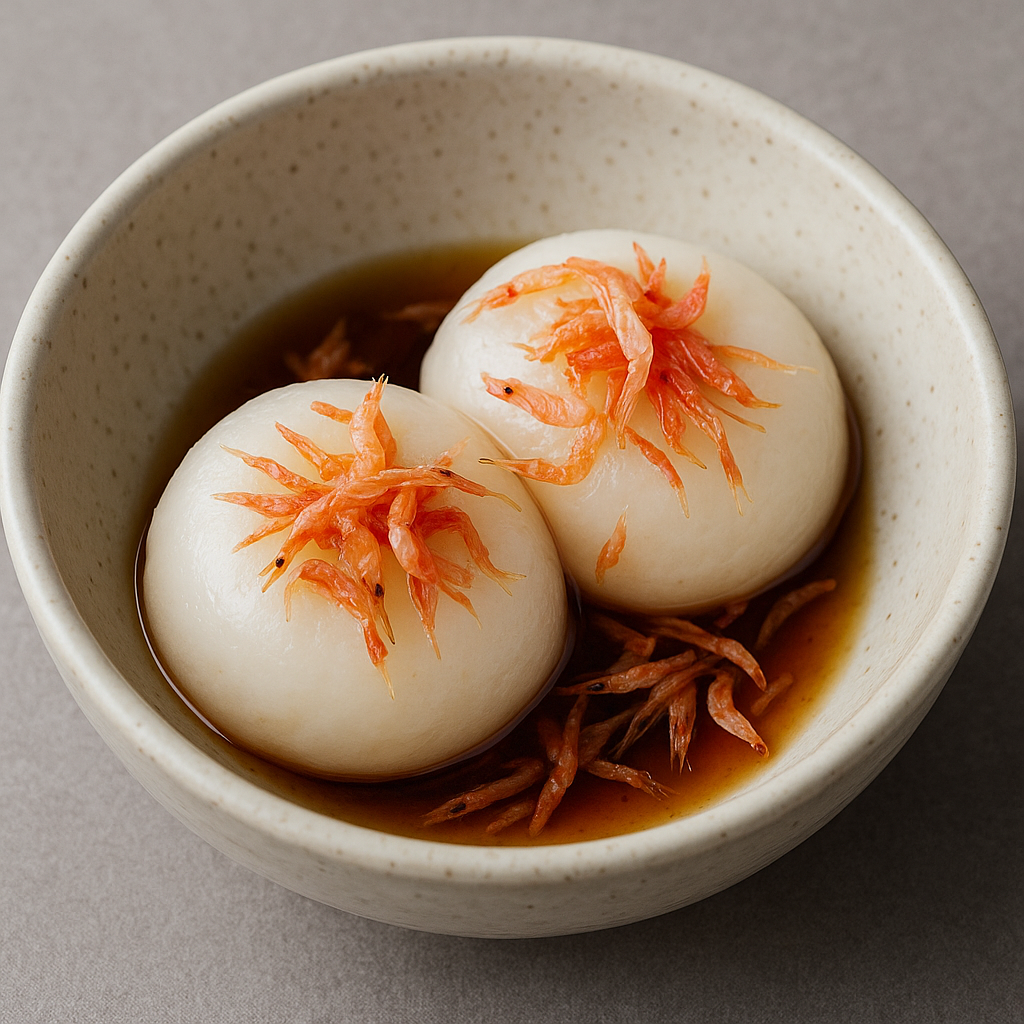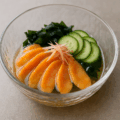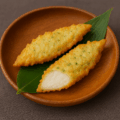えび餅(宮城)の特徴
小えびの香ばしさと甘じょっぱさを、焼き餅にからめて楽しみます
えび餅は、小えび(川えび・アミエビなど)を湯がいたものを、焼いた餅に乗せていただく郷土の食べ方です。餅の軽い焼き目の香りと、小えびの旨みがしょうゆ・味噌などと重なり、あとを引く味わいになります。
干し小えびを“えびだれ”に――配合は家ごとに違います
採れたての小えびを茹で、醤油と絡めるのが基本となっています。家庭によってレシピが異なりますが、シンプルに食べるのが主流です。
えび餅(宮城) レシピ
材料(5人分・餅10個目安)
- 切り餅 … 10個
- 干し小えび … 30〜40g(生よりも乾燥したものが手に入りやすい)
- 醤油 … 大さじ4
- 酒 … 大さじ1
- 干しエビの戻し水 …(要調整)
作り方
- 干し小えびを水で戻し、完璧に戻ったら湯通しする。
- 戻し汁と酒、醤油を混ぜ合わせて、加熱してタレにする。
- 餅をグリル/トースター/フライパン(油ごく薄く)で、両面に軽い焼き目がつくまで焼く(またはゆでて柔らかくする)。
- 熱いうちに餅にえびを乗せ、タレをかけて食べる。
シェフのワンポイントアドバイス
- たれは液体で少しずつ濃度調整します。干しエビの旨味を活かす為に、干しエビを戻す時は可能な限り、少ない水で調理する。
- 餅は膨らみ始めで火を止めると、外は香ばしく中はもちっと仕上がります。
栄養価(1人分の目安)
- エネルギー … 200〜300 kcal
- たんぱく質 … 7〜12 g(小えび・餅由来)
- 脂質 … 5〜12 g
- 炭水化物 … 45〜65 g(餅由来)
- カルシウム・アスタキサンチン … 小えび由来
歴史
小えびを生かす保存の知恵が、餅のたれに結びつきました
沼で獲れた小えびを正月や来客対応に用いていました。現在では日常的に食べることもあり、おやつとして未だに親しまれています。
English Version
Features of Ebi Mochi (Miyagi)
Toasty baby shrimp with a sweet–savory glaze over grilled mochi
Ebi mochi is a local style where lightly grilled mochi is topped with small shrimp (river shrimp or krill) and finished with a soy-based glaze. The faint char on the mochi pairs with the shrimp’s umami and a soy or miso accent for an addictive bite.
Dried shrimp “ebi sauce” — simple, household-specific formulas
Fresh-caught baby shrimp are often blanched and seasoned simply with soy; many homes also use dried shrimp rehydrated and simmered into a quick glaze. The minimalist approach is the norm.
Ebi Mochi (Miyagi) – Recipe
Ingredients (Serves 5 • about 10 mochi)
- Kirimochi (cut rice cakes) … 10 pieces
- Dried baby shrimp … 30–40 g (easier to source than fresh)
- Soy sauce … 4 Tbsp
- Sake … 1 Tbsp
- Shrimp soaking liquid … as needed (to adjust glaze)
Directions
- Rinse dried shrimp and soak in minimal cold water until softened; briefly blanch and drain.
- Combine soaking liquid, sake, and soy sauce; simmer to make a light glaze.
- Grill/toast mochi (or soften by boiling) until lightly browned on both sides.
- Top hot mochi with the shrimp and spoon the glaze over just before serving.
Chef’s Tips
- Adjust glaze thickness gradually with the soaking liquid—keep it glossy, not watery.
- Use the least water possible to soak shrimp so the flavor stays concentrated.
- Pull mochi when it just starts to puff: crisp outside, chewy inside.
Nutrition (per serving, approx.)
- Energy … 200–300 kcal
- Protein … 7–12 g (shrimp/mochi)
- Fat … 5–12 g
- Carbohydrates … 45–65 g (mochi)
- Calcium & astaxanthin … from shrimp
History
Preserving tiny shrimp led to a flavorful topping for mochi
Small shrimp from ponds and rivers were used for festive and guest meals; today the dish is also enjoyed casually as a snack. The simple shrimp-and-soy treatment remains beloved.



何でも質問してください!